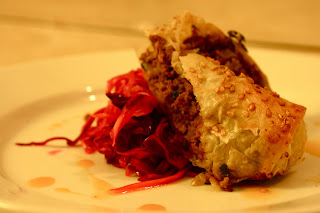
At last month's Sunday Suppering - the underground restaurant we put on once a month - we started off the 5-course meal with a bang. Call me crazy, call it heavy, but our first course was an individually wrapped filo log, bursting with sweet and savory cinnamony lamb, sitting atop a cabbage slaw with some harissa oil drizzled around. Oh boy.

It's true, I've been crazy for filo wrapped deliciousness of all sorts these days. While the filo is delicate and can be difficult to work with at first, it also can be molded into all sorts of shapes and is a vessel for whatever filling you're in the mood for, especially those with Mediterranean flavors. Brush it with egg or oil and sprinkle some sesame seeds over it, and when you pull it from the oven you have a golden brown crispy shell you can't wait to sink your teeth into.
This recipe is easy enough to prepare any day of the week, but fancy enough to serve to impress. *Don't forget to score the product before you put it in the oven if you plan on cutting it to serve - this will allow you to cut without filo crumbling everywhere. You can also roll this into one long log and serve as slices. Serve over cabbage slaw.

 Lamb Filo Logs
Lamb Filo Logsmakes 8 appetizer sized logs
1 lb ground lamb
½ cup toasted pine nuts
½ large onion, diced
2 cloves garlic, minced
1 tbsp olive oil + 1 small bowl with olive oil
1 tsp sea salt
½ cup white wine
2 tsp coriander seed
½ tsp fennel seed
½ tsp mustard seed
1 tsp cumin seed
½ tsp fenugreek
2 tsp ground cinnamon
1/3 bunch parsley, chopped fine
2 tsp chopped thyme
2 tbsp grated parmesan
¼ cup packed dried apricots, chopped well
1 egg
½ cup sesame seeds
On medium heat, sweat down onions, garlic & salt in a large sauté pan. Turn heat to high and add lamb, mixing well with the onions. Spread lamb evenly on pan and allow to brown, then break up mixture by finely chopping with a wooden spoon, so the lamb crumbles. Continue to brown, then add wine. Continue to simmer, allowing the wine to cook off. Once lamb is just cooked through and liquid is mostly cooked off, remove from heat.
In a small sauté pan on medium heat add coriander, fennel, mustard & cumin and heat until fragrant. Add fenugreek and cinnamon and remove from heat. Grind in a spice grinder. Mix lamb mixture with spices and all remaining ingredients.
Preheat oven to 400. Take one piece of filo dough and cut in half. (Always keep remaining filo covered with a slightly damp towel so it doesn’t dry when you’re working with another piece – if the towel is wet it will soak the filo, so make sure you wring it out well). Brush one half piece with olive oil, then put the other half on top of it and brush with olive oil again. Place one more half of filo on top and brush with oil. Cut oiled filo in half width-wise, so you have two squares. Place 1/3 cup lamb mixture in the middle of one square, pressing out so you still have 1” free on either side of mixture. Fold the outer edges in, then roll out creating a log. Bind the end by brushing oil over the end and the piece of filo it attaches to. Brush the top of the log with olive oil and sprinkle with sesame seeds. Repeat process until filling is done. Bake on an oiled sheet tray for 12-15 minutes or until browned.
makes 4 cups of fillingCabbage Slaw¼ head of cabbage, sliced thin
¼ head of red cabbage, sliced thin
½ carrot, julienned
1 rutabega, julienned
1 watermelon radish, julienned
1 inch green garlic, sliced thin cross-wise
1 tbsp sugar
1 tbsp salt
2 tbsp brown rice vinegar
2 tbsp champagne vinegar
Combine cabbage, carrots, rutabega, radish and green garlic with the sugar and salt. Mix well, and place in colander in a bowl. Weigh down vegetables with something heavy and allow to sit and drain for 15 minutes. Toss drained liquid and move veggies to the bowl. Mix with vinegars and weigh down again, for 15 – 30 minutes, mixing a few times. (vegetables can sit in vinegars for up to a couple of hours). Serve with filo wrapped lamb.
























